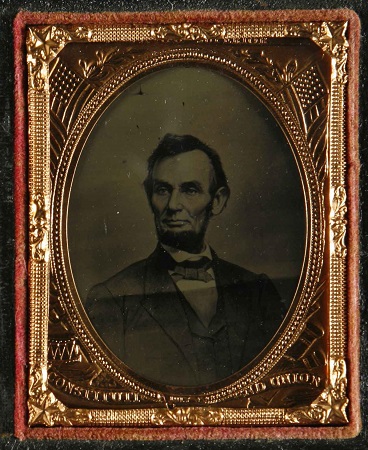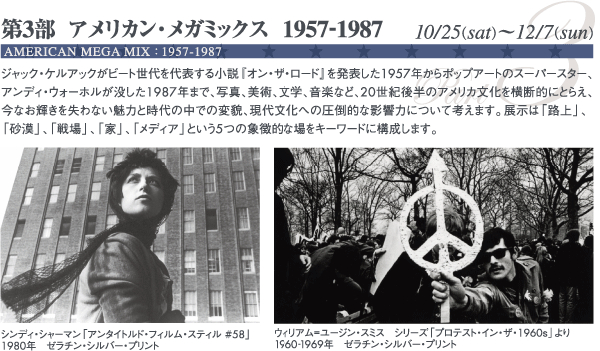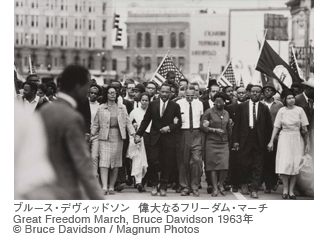
Part 1 The Star-Spangled Banner
Mathew Brady’s Studio, Title Unknown (Portrait of Abraham Lincoln), c.1860
Visions of America
Part3 AMERICAN MEGAMIX 1957-1987
Oct. 25—Dec. 7, 2008
- Oct. 25—Dec. 7, 2008
- Closed Monday(if Monday is a national holiday or a substitute holiday, it is the next day)
- Admission:Adults ¥500/College Students ¥400/High School and Junior High School Students,Over 65 ¥250
The United States has been a world leader in photography from its pioneering days through the present, but its influence was especially great during the twentieth century. That nation has also been crucially important as both a creative setting and a subject for not only American but also European and Asian photographers.
Visions of America, an exhibition in three parts from the collection of the Tokyo Metropolitan Museum of Photography, introduces many types and styles of photography from the United States, from nineteenth-century daguerreotypes to contemporary work. Selected from the 24,000 photographs in the museum's collection, these works are being exhibited by period. As the series unfolds, the Visions of America exhibition presents not only a view of the history of the United States since its foundation but also the multi-layered nature of its culture, with its complex relationships between the global and the local.
The third part of this exhibition, American Mega Mix: 1957-1987, opens in October and introduces a host of star photographers who are well known in Japan. This is an exhibition that everyone, photography aficionado or not, will enjoy. It offers a magnificent opportunity to look anew at the United States from the viewpoint of photography and at the history of photography as well.
Highlights of Visions of America, Part III
1.On the Road/On the Streets
Wasn't so much of the dynamism of postwar American culture to be found on the road? Street photography--Americans, by Robert Frank or New York, by William Klein--overturned the conventional notion of documentary photography to lay the roots of contemporary photography. In this section, we show America actively on the road from the mid 1950s to the 1980s, through the work of Lee Friedlander, who questioned the relationship between image and reality, Duane Michals, who expressed the potential for encounters on the road through sequential photographs, and Garry Winogrand, who dynamically captured images of passersby on the streets.
2.In the Desert
What did photographers seek in the vast deserts of the American West, and what did they find there? Desert scenery fascinated photographers as visions symbolizing America. Henry Wessel focused on desert landscapes dotted with man-made artifacts, on the boundaries between civilization and nature. Richard Misrach documented the human transformation of a desert. Shinoyama Kishin placed nude models--contemporary physical beauty--in primitive desert landscapes. Shirakawa Yoshikazu captured awe-inspiring natural beauty on a global scale, and Narahara Ikko discovered a mythical time and space, as the planetary scale of the scenery of the western deserts spurred the imaginations of Japanese photographers.
3.In the Battlefields
During the upheavals of the 1960s, the military battlefields were in Vietnam, but everywhere in the United States that people sought peace, freedom, and equality also became a battlefield. Life reporter Larry Burrows and Japanese photographers such as Ishikawa Bun’yo and Okamura Akihiko were active during the Vietnam War (1959-1975). The avant-garde artist Ono Yoko engaged in an anti-war campaign, and William Eugene Smith turned a sympathetic eye to the youngsters who gathered for anti-war or civil rights demonstrations or the legendary Woodstock rock festival.
4.At Home
John Fitzgerald Kennedy was assassinated in Dallas, Texas, in 1963. The age in which people could have faith in the American Dream was ending; American identity was fractured. Among photographers, the new uncertainties were reflected in a focus on the themes of family, private lives, the everyday, and locality, as though to reconfirm bonds between people and to search for human relationships. Diane Arbus photographed the negative aspects of human beings in all their naked truth, offering compelling visions that make us aware of America’s inner insanity and the impossibility of understanding each other. William Eggleston, with local landscapes in the South and details of everyday life as his subject, created symbols of home and the suburbs that evoke a contrast between a civilization and the identities of the people whose lives are immersed in it. Sally Mann produced a distinctively transparent visual world by blending real life and fiction in addressing the subject of children and their daily lives. Nan Goldin openly depicted love and sex and relations with friends, taking as her theme the fluidity of human relationships in and around her own life, and becoming in the process the darling of late twentieth-century American photography.
5.On Media
The advances in the media that American technology has made possible have changed the world. The American dream and its fictions, depicted in films and on television, have enthralled us all. The many images generated on the vast stage we call the media have become our vision of America, exerting a huge influence on the rest of the world, from the twentieth century down to the present. The official NASA photographs documenting the Apollo landing on the moon, the first in human history, Andy Warhol's vivid depictions of America in all its light and shadow, Joel-Peter Witkin's depictions of the darkness of human existence, Robert Mapplethorpe, who exemplifies American culture in the 1980s, Cindy Sherman—this part of the exhibition traces the dreams and memories of twentieth-century America woven by fiction and reality.



![チラシ1[pdf]](http://topmuseum.jp/upload/4/384/thums/2008_009_america3.png)
![出品作品リスト1[pdf]](http://topmuseum.jp/upload/4/384/thums/america3.png)